| 摘要: |
| 对2013年全国海洋环境监测1626个站位生物数据进行分析, 以近2001年~2013年在我国近海海域明确发生赤潮的生物作为赤潮引发种, 开展其种类组成和数量分布研究。结果显示: (1)我国近海赤潮引发种隶属于8门60种, 其中产毒种12种, 甲藻27种, 硅藻20种。(2)2013年共监测到上述赤潮引发种50种, 各监测站位种类数在0~25种之间, 平均密度在84~1.16×1011个/m3之间, 赤潮引发种种类数、密度分布大致都呈现近岸至远海递减的趋势, 但在长江口及其邻近海域, 呈现先增大后减小趋势。(3)2013年各海区赤潮引发种种类数在36~42之间, 平均密度渤海>东海>南海>黄海, 多样性指数渤海>黄海>南海>东海, 都以中肋骨条藻(Skeletonema costatum)为优势种。(4)作为高频赤潮引发种,2013年中肋骨条藻(S. costatum)主要分布在我国近岸及近海海域; 夜光藻(Noctiluca scintillans)在我国近岸、近远海海域都有分布; 东海原甲藻(Prorocentrum donghaiense)主要分布在黄海和东海的近岸和近海海域; 米氏凯伦藻(Karenia mikimotoi)分布较为广泛, 但出现的站位较少; 红色中缢虫(Mesodinium rubrum)、赤潮异弯藻(Heterosigma akashiwo)、红色赤潮藻(Akashiwo sanguinea)只在很少区域有分布。该研究结果有助于摸清我国近海海域赤潮生物种类和分布状况, 可为赤潮的预警及其防灾减灾提供基础科学依据。 |
| 关键词: 近海海域 赤潮引发种 种类组成 空间分布 |
| DOI:10.11759/hykx20160227001 |
| 分类号: |
| 基金项目:国家重点研发计划“海洋环境安全保障‘重点专项’海洋大数据分析预报技术研发项目(2016YFC1401906); 中国海洋发展研究中心重大项目“渤海海洋资源开发和环境问题研究”(AOCZDA201205-1) |
|
| Species composition and distribution of red tide causative organisms in the coastal waters of China in 2013 |
|
HUANG Hai-yan,KANG Lin-chong,YANG Yi,YANG Lu,LIU Shu-ming,WANG Qiu-lu,LI Xiao
|
| Abstract: |
| In this study, we analyze the species and distribution of red tide causative organisms in the coastal waters of China on the basis of statistics for the species that caused red tide events during the years 2001 to 2013 in China’s coastal waters and biological data from 1626 stations by National Marine Environmental Monitoring in 2013. Our results indicate (1) There were 60 species in a total of eight phylum organisms, including 12 toxic species that caused red tides in China’s coastal waters from 2001 to 2013. Of these, 27 species were Dinophyta and 20 were Bacillariophyta. (2) A total of 50 species of the above-mentioned red tide causative organisms were detected in 2013, and the number identified by each monitoring station ranged from 0 to 25, with the average abundance recorded by each monitoring station being between 84 cells/m3 and 1.16 × 1011 cells/m3. We found that the species number and cell abundance of the red tide causative organisms decreased from offshore to the open sea; however, both first increased and then decreased in the Changjiang estuary and its adjacent sea area. (3) In 2013, the species numbers in the Bohai Sea, Yellow Sea, East China Sea, and South China Sea ranged from 36 to 42, and the dominant species was Skeletonema costatum. The average abundance of the red tide causative organisms follows the order of Bohai Sea > East China Sea > South China Sea > Yellow Sea. The biodiversity index follows the order of Bohai Sea > Yellow Sea > South China Sea > East China Sea. (4) In 2013, Skeletonema costatum were distributed mainly in inshore and offshore areas; Noctiluca scintillans were distributed in coastal areas and even in open sea areas; Prorocentrum donghaiense were mainly distributed in the inshore and offshore areas of the East China Sea and South China Sea; and Karenia mikimotoi were distributed widely but only detected by a few stations. Mesodinium rubrum, Heterosigma akashiwo, and Akashiwo sanguinea had only a few distribution areas. These species induced red tide with high frequency during the last thirteen years. This study gave a clear picture of the species composition and distribution of red tide causative organisms in the coastal water of China, which has profound significance for the prevention, reduction, and forecast of red tides. |
| Key words: Coastal waters of China Red tide causative species Species composition Distribution |
